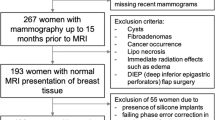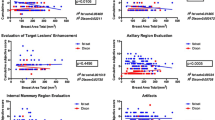Abstract
The signal modulations caused by partial volume effect and phase shift between fat and water signal in gradient-echo magnetic resonance mammography (GRE MR-mammography) have been calculated. Based on this, the theoretical sensitivity and specificity of GRE MR-mammography has been investigated considering different evaluation methods for the gadolinium-diethylenetriamine penta-acetic acid (Gd-DTPA)-based signal enhancement. The results show that both in- and out-of-phase sequences suffer from partial volume effects in voxels that contain both fat and water. This can decrease sensitivity to Gd-DTPA uptake in small, fat-embedded lesions or in pathology that contains fat interspersed histologically. Additionally, out-of-phase sequences can suffer from phase cancellation effects that can further decrease their sensitivity to Gd-DTPA uptake. In the worst case signal can actually decrease during Gd-DTPA influx. Determination of enhancement relative to the baseline value can decrease the specificity of GRE MR-mammography in the out-of-phase condition and decrease the sensitivity in the in-phase condition. These effects are less pronounced when enhancement is calculated relative to fat. These effects need to be understood since Gd-DTPA uptake is the prime indicator of malignancy in MR-mammography.
Similar content being viewed by others
References
Damadian R (1971) Tumor detection by nuclear magnetic resonance.Science 1 1151–1153.
Mansfield P, Morris PG, Ordidge RJ, et al. (1979) Carcinoma in the breast imaged by nuclear magnetic resonance (NMR).Br J Radiol 52 242–243.
El Yousef SJ, Duchnesneau RH (1984) Magnetic resonance imaging of the human breast: a phase I trial.Radiol Clin North Am 22 859–868.
Heywang SH, Hahn D, Schmidt H, et al. (1986) MR imaging of the breast using gadolinium-DTPA.J Comp Assist Tomogr 10 199–204.
Kaiser WA, Zeitler E (1989) MR imaging of the breast: fast imaging sequences with and without Gd-DTPA.Radiology 170 681–686.
Heywang SH, Wolf A, Pruss E, et al. (1989) MR imaging of the breast with Gd-DTPA: use and limitations.Radiology 171 95–103.
Heywang-Koebrunner SH (1990)Contrast enhanced MRl of the breast. Basel: Karger.
Stack JP, Redmond OM, Codd MB, et al. (1990) Breast disease: tissue characterisation with Gd-DTPA enhancement profiles.Radiology 174 491–494.
Kaiser WA (1993)MR Mammography (MRM). Berlin: Springer Verlag.
Orel SG, Schnall MD, Li Volsi VA, et al. (1994) Suspicious breast lesions: MR imaging with radiologic- pathologic correlation.Radiology 190(2 485–493.
Heywang-Köbrunner SH (1994) Contrast-enhanced MR imaging of the breast: comparison of two different doses of gadopentate dimeglumine.Radiology 191(3 639.
Sittek H, Kessler M, Bredl T et al. (1994) Breast malignancies: dynamic FLASH 3D MR-mammography versus mammography.Radiology 193(P) 121.
Kaiser WA, Hahn D (1995) Diagnostic pitfalls in dynamic MR-mammography.European Radiology 5(Suppl. 264.
Heywang-Köbrunner SH, Viehweg P, Kósling S, et al. (1995) Contrast-enhanced MRI of the breast: technical aspects and pitfalls.European Radiology 5(Suppl. 264.
Rubens D, Totterman S, Chacko AK, et al. (1991) Gadopentate dimeglumine-enhanced chemical-shift MR imaging of the breast.Am J Radiol 157 267–270.
Harms S, Flamig DP, Hesley KL, et al. (1993) MR imaging of the breast with rotating delivery of excitation off resonance: clinical experience with pathologic correlation.Radiology 187 493–501.
Author information
Authors and Affiliations
Rights and permissions
About this article
Cite this article
Peller, M., Stehling, M.K., Sittek, H. et al. Effects of partial volume and phase shift between fat and water in gradient-echo magnetic resonance-mammography. MAGMA 4, 105–113 (1996). https://doi.org/10.1007/BF01772517
Received:
Accepted:
Issue Date:
DOI: https://doi.org/10.1007/BF01772517




